(完整版)英语中考复习教案专题五--情态动词
初中情态动词教案

初中情态动词教案课程目标:1. 学生能够理解情态动词的概念和用法。
2. 学生能够正确运用情态动词进行造句。
3. 学生能够区分不同情态动词的含义和用法。
教学内容:1. 情态动词的概念和分类。
2. 情态动词的用法和注意事项。
3. 练习和应用。
教学步骤:一、引入(5分钟)1. 向学生介绍情态动词的概念,让学生初步了解情态动词。
2. 提问学生,了解他们对情态动词的已有知识。
二、讲解(15分钟)1. 讲解情态动词的分类,如can, may, must, could, might, should等。
2. 举例解释每个情态动词的用法和含义。
3. 强调情态动词的用法和注意事项,如情态动词后面要跟动词原形,情态动词不能和助动词连用等。
三、练习(15分钟)1. 让学生分组,每组选择一个情态动词,用这个情态动词造句。
2. 让学生互相交换句子,并判断句子的正确性。
3. 让学生在班级内分享他们的句子,并解释为什么使用这个情态动词。
四、应用(15分钟)1. 让学生写一篇小短文,运用所学的不同情态动词。
2. 让学生互相交换短文,并进行评价和修改。
3. 让学生在班级内分享他们的短文,并解释他们为什么选择使用这些情态动词。
五、总结(5分钟)1. 对本节课的内容进行总结,让学生巩固所学知识。
2. 回答学生的疑问,并进行解答。
教学评价:1. 观察学生在练习中的表现,了解他们对于情态动词的掌握程度。
2. 评价学生在应用环节的短文,了解他们能否正确运用情态动词。
3. 收集学生的反馈意见,了解他们对情态动词的理解和运用情况。
教学反思:本节课通过讲解、练习和应用等环节,让学生掌握了情态动词的概念和用法。
在教学过程中,要注意让学生充分理解和掌握情态动词的用法,并能够正确运用情态动词进行造句。
同时,要注重学生的实际应用能力的培养,让他们能够在实际情境中灵活运用情态动词。
中考英语 情态动词复习教案(表格式)

中考英语情态动词复习教案(表格式)一、教学目标1. 掌握常见的情态动词及其基本意义和用法。
2. 能够正确运用情态动词进行句子构建和交流。
3. 提高学生对情态动词在考试中的解题能力。
二、教学内容1. can的用法:表示能力、允许、请求、可能性等。
示例:I can swim.(我会游泳。
)示例:You can e in.(你可以进来。
)2. may的用法:表示请求、允许、可能性等。
示例:May I borrow your book?(我可以借用你的书吗?)示例:There may be a meeting tonight.(今晚可能有会议。
)3. must的用法:表示肯定、必要、猜测等。
示例:You must study hard.(你必须努力学习。
)示例:It must be rning outside.(外面一定在下雨。
)4. shall的用法:表示承诺、警告、命令等。
示例:I shall call you back.(我会给你回电话。
)示例:You shall not enter without permission.(未经允许不得进入。
)5. will的用法:表示意志、承诺、将来时态等。
示例:I will go to the party.(我会去参加派对。
)示例:He will help you.(他会帮助你。
)三、教学方法1. 实例讲解:通过具体例句讲解每个情态动词的用法。
2. 表格对比:列出各情态动词的用法表格,进行对比分析。
3. 练习巩固:设计相关练习题,让学生巩固所学内容。
4. 小组讨论:分组讨论情态动词的用法,促进学生互动。
四、教学步骤1. 导入:简要介绍情态动词的概念及重要性。
2. 讲解:分别讲解每个情态动词的用法,并结合实例演示。
3. 对比:展示各情态动词用法表格,让学生进行对比分析。
4. 练习:设计练习题,让学生进行课堂练习。
5. 讨论:分组讨论练习题,引导学生互相交流心得。
情态动词英语教案
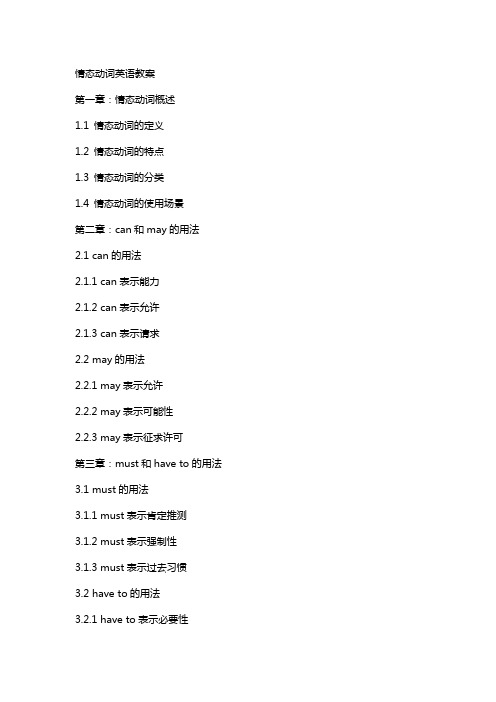
情态动词英语教案第一章:情态动词概述1.1 情态动词的定义1.2 情态动词的特点1.3 情态动词的分类1.4 情态动词的使用场景第二章:can和may的用法2.1 can的用法2.1.1 can表示能力2.1.2 can表示允许2.1.3 can表示请求2.2 may的用法2.2.1 may表示允许2.2.2 may表示可能性2.2.3 may表示征求许可第三章:must和have to的用法3.1 must的用法3.1.1 must表示肯定推测3.1.2 must表示强制性3.1.3 must表示过去习惯3.2 have to的用法3.2.1 have to表示必要性3.2.2 have to表示过去不得不3.2.3 have to表示将来不得不第四章:情态动词的否定句和疑问句4.1 情态动词的否定句4.1.1 构成方式4.1.2 否定句的用法4.2 情态动词的疑问句4.2.1 构成方式4.2.2 疑问句的用法第五章:情态动词的时态配合5.1 情态动词与一般现在时5.2 情态动词与一般过去时5.3 情态动词与一般将来时5.4 情态动词与现在进行时5.5 情态动词与过去进行时5.6 情态动词与现在完成时5.7 情态动词与过去完成时5.8 情态动词与将来完成时第六章:情态动词短语6.1 情态动词+动词原形6.2 情态动词+be+动词ing6.3 情态动词+have+过去分词6.4 情态动词+do/does/did+动词原形6.5 情态动词+would+动词原形第七章:情态动词的常用表达7.1 情态动词+not+动词原形7.2 情态动词+疑问词+动词原形7.3 情态动词+ever+动词原形7.4 情态动词+for+名词/代词+动词原形7.5 情态动词+不定式第八章:情态动词在特定场景中的应用8.1 情态动词在日常生活场景中的应用8.2 情态动词在工作场景中的应用8.3 情态动词在教育场景中的应用8.4 情态动词在社交场景中的应用8.5 情态动词在旅游场景中的应用第九章:情态动词的翻译技巧9.1 情态动词的直译9.2 情态动词的意译9.3 情态动词的转译9.4 情态动词的省略译9.5 情态动词的特殊译法第十章:情态动词的练习与巩固10.1 情态动词的选择题10.2 情态动词的填空题10.3 情态动词的翻译题10.4 情态动词的口语练习10.5 情态动词的综合练习第十一章:情态动词在阅读理解中的应用11.1 情态动词在阅读理解中的重要性11.2 情态动词在推理判断中的应用11.3 情态动词在事实细节查找中的应用11.4 情态动词在作者态度推断中的应用11.5 情态动词在阅读练习中的实际操作第十二章:情态动词在写作中的运用12.1 情态动词在写作中的作用12.2 情态动词在表达观点和态度中的应用12.3 情态动词在提出建议和请求中的应用12.4 情态动词在叙述过去事件中的应用12.5 情态动词在写作练习中的实际操作第十三章:情态动词在听力理解中的应用13.1 情态动词在听力理解中的重要性13.2 情态动词在理解说话者意图中的应用13.3 情态动词在捕捉关键信息中的应用13.4 情态动词在对话情境理解中的应用13.5 情态动词在听力练习中的实际操作第十四章:情态动词在口语交流中的应用14.1 情态动词在口语交流中的重要性14.2 情态动词在表达可能性中的应用14.3 情态动词在表达意愿和决心中的应用14.4 情态动词在提出问题和回答中的应用14.5 情态动词在口语交流练习中的实际操作第十五章:情态动词的测试与评估15.1 情态动词的测试类型15.2 情态动词的测试题型15.3 情态动词的评估标准15.4 情态动词的自我评估15.5 情态动词的提升策略重点和难点解析本文主要介绍了情态动词的基本概念、用法、语法规则、实际应用场景、练习与测试等各个方面。
中考情态动词专项复习教学设计
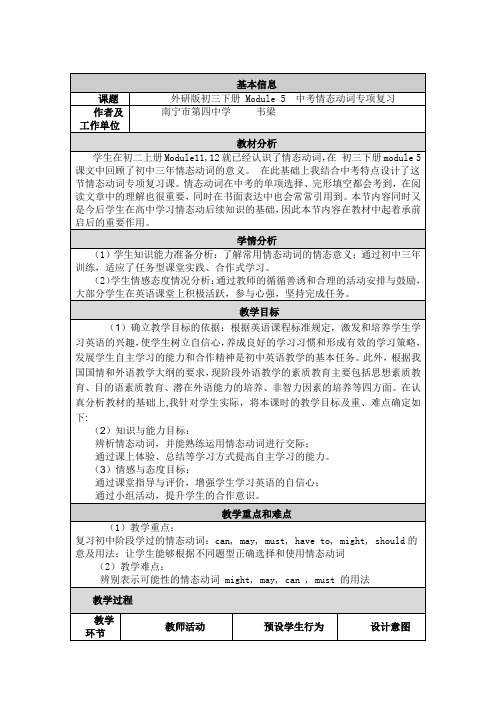
附件:中考情态动词专项复习学案一、考点归纳基础过关写出下列常见情态动词的基本含义和用法1.can/could _______ _______ _______ ________can’t/couldn’t_______ _______ _______ ________2.may/might _______ _______ may not ________3.must________ _________4.mustn’t__________5.needn’t___________6.have to__________ _________ don’t have to_______7.will/would_________ ________ _________8.shall __________ should_________ shouldn’t__________9. had better _______________10. --May / Can I use your cell phone ?的否定回答:--No,you___________. 或No, you____________.11. --Must I finish the work today?的否定回答:--No,you ____________.或No,you ______________.12. --Would you like some juice?肯定回答用______________.否定回答用______________.13. --Shall we go to Nanning No.4 high school?肯定回答用______________.否定回答用_____________.14.—Would you like to go to Nanning No.4 high school?肯定回答用______________.否定回答用_____________.二、真题训练中考实战1. --I hear you’ve got a new bike. ______ I have a look?(2012 苏州)--Yes, certainly.A. MayB. DoC. ShallD. Should2. --Honey , stay at home before I return.(2013 武汉)--I ________, Mum.A. mustB. canC. shouldD. will3. People _______ always be careful with fire, or it can be dangerous.A. canB. needn’tC. mustD. shouldn’t4. --Must we leave for Shanghai now?--No, we ___________. We still have two more hours.A. can’tB. mustn’tC. needn’tD. shouldn’t5.You _______ drive your car so fast. It’s very dangerous.(2013 安徽)A. wouldn’tB. shouldn’tC. couldn’tD. needn’t6. --Can I walk across the road now, mum?(2012 南通)--No, you ___________. You have to wait until the light turns green.A. couldn’tB. shouldn’tC. mustn’tD. needn’t7. --Is Maria knocking at the door? (2012 黄石)--It_________ be her. She is in Australia now.A. can’tB. mustC. mayD. mustn’t8. --Must I finish the homework this afternoon? (2013 钦州)--No,you needn’t . It _________ before Friday.A. can finishB.must finishedC. can be finishedD. must befinished9. --Would you like to see a film with me?--_________.A. yes, I like.B. yes, I would.C. Yes, I would like.D. Yes, I’d like to.10. --Could you please help me choose a camera online?--__________. My computer doesn’t work.A. I’m afraid I can’tB. I don’t careC. I hope soD. Certainly.11. Would you please__________the window? It’s so cold outside.A. openB. openingC. not openD. not to open12. We'd better ______out ,it's raining heavily outside.A.goB.to goC.not goD.not to go三、情景实践能力提升针对下列三种情景,提出你的合理建议。
情态动词知识点教案设计

情态动词知识点教案设计一、教学目标:1. 了解情态动词的定义和用途;2. 掌握情态动词的基本用法和意义;3. 能够运用情态动词进行语言表达。
二、教学重点与难点:1. 掌握情态动词的基本用法;2. 理解情态动词的语义差异;3. 运用情态动词进行语言表达。
三、教学准备:教师准备多媒体教具、情态动词知识点PPT、练习题等。
四、教学过程:Step 1:导入(5分钟)教师通过提问和引入视频或图片等活跃课堂氛围,激发学生对情态动词的兴趣。
Step 2:概念讲解(15分钟)1. 教师通过PPT展示情态动词的定义和特点,并解释其在句子中的作用;2. 介绍常见的情态动词有can, could, may, might, will, would, shall, should, must等;3. 引导学生理解情态动词的语义,如表示能力、允许、可能性、推测、意愿、建议、命令等。
Step 3:用法解析(20分钟)1. 教师通过PPT详细讲解情态动词的基本用法,包括肯定句、否定句、疑问句以及其它常用句型;2. 强调情态动词在句子中的位置和变化规律;3. 通过例句和练习题让学生进行互动讨论,加深理解。
Step 4:情态动词间的区别(15分钟)1. 教师列举常见的情态动词,并比较它们的不同用法和意义;2. 强调should的建议、can的能力、must的必需、may的可能性等;3. 让学生进行小组对话或问答练习,加深理解情态动词的语义差异。
Step 5:情景对话(20分钟)1. 教师设计情景对话,让学生运用情态动词进行表达;2. 学生分角色进行对话练习,模拟真实情境;3. 教师适时提供反馈和指导,纠正学生的错误,并鼓励学生积极表达。
Step 6:巩固练习(15分钟)教师分发练习题,让学生独立完成,然后进行讲评,强化对情态动词的掌握程度。
Step 7:拓展延伸(5分钟)教师提供情景讨论或写作活动,让学生运用情态动词进行表达。
五、教学反思:通过本节课的情态动词知识点教案设计,利用多媒体和互动教学方式,激发学生对情态动词的兴趣,帮助学生理解情态动词的基本概念、用法和语义差异,并通过情景对话和练习题的训练,提高学生的语言表达能力。
外研版中考英语语法复习专题--情态动词教案

(二)情态动词的种类:(见下表)
原形
过去式
词义
can
could
能
may
might
可以(或许)
must
must(had to)
必须(不得不)
will
would
愿意
shall
should
应该
(三)情态动词的否定形式:
cannot --- can’tcould not --- couldn’tmay not--- mayn’t
(考点1,情态动词的本身含义表格中常考的情态动词均有现在和过去,用法:1、表过去式,用于疑问句中,语气比较委婉)
(四)常用情态动词的用法:(考点2情态动词的常规考法和特殊考法)
1.can与could
1).can
(1)表示体力或脑力方面的“能力”,也能表示根据客观条件能做某事的“能力”。
He can drive.
(1)can的过去式,表示过去有能力及过去的可能性。
He couldn’t climb up the mountain.
The news could be true.
(2)表示客气地请求或委婉地陈述意见。
Could you go skating with me tomorrow?
I’m afraid I couldn’t give you an answer tonight.
2) need引导的疑问句,肯定回答时多用must,否定回答时用needn’t。
Need he come? Yes, he must.No, he needn’t.
3) need后接名词做宾语时,表示“需要”某件事物,此时用作实义动词,与一般的实义动词用法完全一样,有时态和数的变化。如:
英语中考复习教案专题五情态动词

学习过程一、复习预习复习上节内容,画助动词、实义动词的时态特点图,词性和句子成分对应图二、知识讲解考点1---情态动词特点与分类1、情态动词:情态动词具有有一定的词义,没有人称和数的变化,不能单独作谓语,必须和谓语动词连用才能构成谓语,给谓语动词增添情态色彩,表示说话人的态度、看法、语气、愿望或推测等。
2、情态动词分类:①只做情态动词:must,can(could),may(might),ought to②可做情态动词又可做实义动词:need,dare③可做情态动词又可做助动词:shall(should),will(would)④具有情态动词特征:have(had) to,used to考点2---情态动词用法用法:情态动词+行为动词原形情态动词数量不多,但用途广泛,主要有下列:can /could, may/might, must, need, ought to, dare/dared, shall/should, will/would,have(to) ,had better.must和have to的用法1.表示必须、必要、一定。
(must表示主观多一些而have to则表示客观多一些)如: You must come in time.回答must的问句时,肯定回答为must,否定回答用needn't或don't have to。
— Must we hand in our exercise books today?— Yes, you must. (No,you needn’t.或No, you don’t have to.)2.Must用于肯定的判断、推测时,表示的可能性最强。
The light is on ,so he must be at home now.其反义疑问句要用实际问句的助动词来构成She must have seen the film before, hasn’t she?You must met uncle wang in the shop yesterday, _________?3.否定形式mustn’t表示“一定不要、千万别、禁止、不许”You mustn’t play with fire.will和would的用法1. 表示请求、建议等,would比will委婉客气。
中考英语复习《情态动词》精品教学案
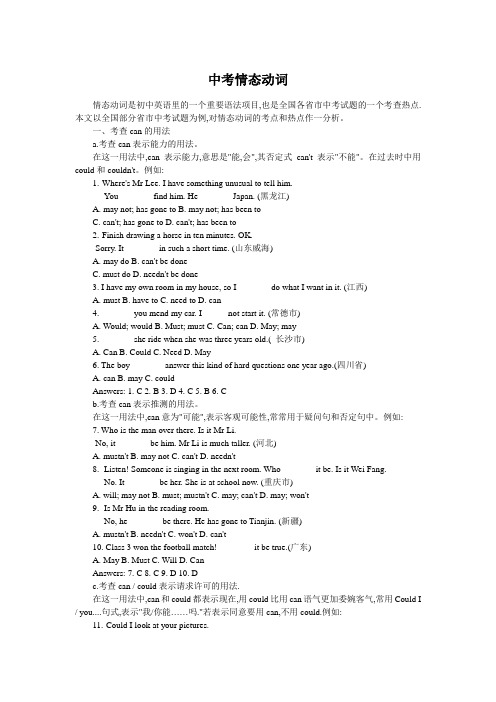
中考情态动词情态动词是初中英语里的一个重要语法项目,也是全国各省市中考试题的一个考查热点.本文以全国部分省市中考试题为例,对情态动词的考点和热点作一分析。
一、考查can的用法a.考查can表示能力的用法。
在这一用法中,can表示能力,意思是"能,会",其否定式can't表示"不能"。
在过去时中用could和couldn't。
例如:1.-Where's Mr Lee. I have something unusual to tell him.-You________find him. He________Japan. (黑龙江)A. may not; has gone toB. may not; has been toC. can't; has gone toD. can't; has been to2.-Finish drawing a horse in ten minutes. OK.-Sorry. It________in such a short time. (山东威海)A. may doB. can't be doneC. must doD. needn't be done3. I have my own room in my house, so I________do what I want in it. (江西)A. mustB. have toC. need toD. can4.________you mend my car. I______not start it. (常德市)A. Would; wouldB. Must; mustC. Can; canD. May; may5.________she ride when she was three years old.( 长沙市)A. CanB. CouldC. NeedD. May6. The boy________answer this kind of hard questions one year ago.(四川省)A. canB. mayC. couldAnswers: 1. C 2. B 3. D 4. C 5. B 6. Cb.考查can表示推测的用法。
中考英语 情态动词复习教案(表格式)

中考英语情态动词复习教案(表格式)一、教学目标:1. 掌握常见的情态动词,包括can, may, must, could, might, shall, will等。
2. 学会区分情态动词的用法,如表能力、可能性、建议、命令等。
3. 能够正确运用情态动词构造句子,表达推测、请求、承诺等意义。
二、教学重难点:1. 情态动词的辨析及用法。
2. 情态动词在特定语境中的运用。
三、教学方法:1. 任务型教学法:通过完成各种任务,让学生在实际运用中掌握情态动词的用法。
2. 互动式教学法:引导学生进行小组讨论、pr work等,提高学生的参与度和积极性。
四、教学准备:1. PPT课件:情态动词表格式教案。
2. 练习题:针对不同情境的填空、选择、改写等练习。
五、教学过程:1. 导入:以一段对话或故事引入情态动词,激发学生的兴趣。
2. 呈现:通过PPT展示情态动词表格式教案,引导学生观察和思考。
3. 讲解:讲解每个情态动词的用法,举例说明。
4. 练习:让学生完成PPT上的练习题,巩固所学知识。
5. 小组讨论:学生分组,讨论如何运用情态动词描述certn situations。
6. 分享:每组选代表分享讨论成果,大家互相评价、学习。
7. 总结:教师对情态动词的用法进行归纳总结。
8. 作业布置:布置针对性的练习题,让学生课后巩固。
9. 课后反馈:收集学生的作业,及时给予反馈和指导。
10. 课程拓展:引导学生关注情态动词在实际生活中的应用,提高语言运用能力。
六、教学评价:1. 课堂参与度:观察学生在课堂上的发言和互动情况,评估他们的积极参与程度。
2. 练习完成情况:检查学生完成的练习题,评估他们对情态动词用法的掌握程度。
3. 小组讨论:评估学生在小组讨论中的表现,包括他们的合作能力和语言表达能力。
七、教学拓展:1. 举办情态动词角色扮演活动:让学生在具体情境中运用情态动词,提高他们的实际运用能力。
2. 观看相关视频或阅读文章:通过视频或文章,让学生进一步了解情态动词在实际语境中的运用。
初中英语情态动词教案

初中英语情态动词教案一、教学目标:1. 了解情态动词的概念及基本用法;2. 学习情态动词 can 的用法,能够正确运用 can 表示能力;3. 学习情态动词 must 的用法,能够运用 must 表示推测和必要性;4. 学习情态动词 should 的用法,能够正确运用 should 表示建议和义务;5. 学习情态动词的否定形式和疑问形式,能够准确运用情态动词完成肯定、否定和疑问句。
二、教学重点与难点:1. 情态动词 can、must 和 should 的基本用法;2. 能够准确运用情态动词完成各种句子形式。
三、教学准备:教学课件、教学录像、黑板、白板、课本、练习题等。
四、教学过程:1. 热身导入教师可通过呈现有关能力、推测和建议的场景图片或视频,引导学生进行讨论,激发学生对情态动词的兴趣。
2. 新知呈现教师通过幻灯片或课件介绍情态动词的概念,并列举出常见的情态动词有 can、must 和 should。
让学生跟读例句,感受情态动词的用法和特点。
3. 情态动词 can 的用法讲解和练习(1)教师讲解 can 的基本用法,如表示能力和允许等。
并给予学生示范运用 can 表达能力的练习。
(2)教师板书 can 的肯定、否定形式和疑问形式,并给学生解释其构成和用法,要求学生在小组内互相练习,并展示出来。
4. 情态动词 must 的用法讲解和练习(1)教师讲解 must 表示推测和必要性的用法,并给予学生相关练习。
(2)教师引导学生用must 结合实际情景进行情态动词的运用练习。
5. 情态动词 should 的用法讲解和练习(1)教师讲解 should 表示建议和义务的用法,并给予学生相关练习。
(2)教师组织学生分角色进行对话练习,使学生能够正确表达建议和义务。
6. 情态动词的综合运用教师呈现一段对话或短文,让学生在课堂上进行整体理解,并根据问题回答、补全短文等活动,以提高学生对情态动词的综合运用能力。
7. 拓展延伸(1)教师可通过提问或让学生表演等形式,进一步巩固学生对情态动词的理解。
英语中考复习教案专题五--情态动词

学习过程一、复习预习复习上节内容,画助动词、实义动词的时态特点图,词性和句子成分对应图二、知识讲解考点1---情态动词特点与分类1、情态动词:情态动词具有有一定的词义,没有人称和数的变化,不能单独作谓语, 必须和谓语动词连用才能构成谓语,给谓语动词增添情态色彩,表示说话人的态度、看法、语气、愿望或推测等。
2、情态动词分类:①只做情态动词:must,ca n( could),may(might),ought to②可做情态动词又可做实义动词:need,dare③可做情态动词又可做助动词:shall(should),will(would)④具有情态动词特征:have(had) to,used to考点2---情态动词用法用法:情态动词+行为动词原形情态动词数量不多,但用途广泛,主要有下列:can /could, may/might, must, n eed, ought to, dare/dared, shall/should, will/would,have(to) ,had better. must和have to 的用法1. 表示必须、必要、一定。
( must表示主观多一些而have to 则表示客观多一些)女口:You must come in time.回答must的问句时,肯定回答为must,否定回答用need n't 或don't have to—Must we hand in our exercise books today?—Yes, you must. (No,you needn ' t. 或No, you don ' t have to.)2. Must用于肯定的判断、推测时,表示的可能性最强。
The light is on ,so he must be at home now.其反义疑问句要用实际问句的助动词来构成She must have seen the film before, hasn ' t she?You must met uncle wang in the shop yesterday, ________ ?3. 否定形式mustn ' t表示“一定不要、千万别、禁止、不许”You mustn ' t play with fire.will 和would的用法1. 表示请求、建议等,would比will委婉客气。
中考英语总复习《情态动词》教案

Revision of Modal Verbs Lesson PlanTeaching Aims:●Knowledge aim: Review the modal verbs learned in Junior High.●Ability aim: Learn to use mind maps to organize the thinking●Emotional aim: Learn to be cooperative and positive.Teaching Important PointsModal verbs: can, could, may, might, would, should, shallTeaching difficulties:1.Modal verbs used to talk about the abilities.2.Modal verbs used to ask for permission or help.3.Modal verbs used to give advice4.“Must” questions and answers5.Modal verbs for making referencesTeaching Aid: PPTTeaching Periods: 2 PeriodsPeriod 1:Teaching Steps:Step 1 : Free talk to students to lead into the topic and tell the general rules when using modal verbs.Step 2: Presentation 1 – Can / Could1.Show the mind map2.Give some examples for each usage.3.Activity 1: What can you do ?4.Activity 2: A survey5.Finish the quizStep 3: Presentation 2: Mind map 2 (may, could, can)1.Finish Mind Map 22.Ask students to do an activity-make a conversation using may, could orcan.3.Finish the quiz.Step 4: Presentation 3: Mind map 3 (shall, should)1.Finish the mind map with the students.2.Ask the students to do give some examples.3.Ask students to do the activity-sentence train.Step 5: SummaryStep 6: Homework1.Make a mind map for modal verbs can, could, may, must.Period 2Step 1: Review: Free talk to students and lead in the topic.Step 2: Presentation: Mind map 41.Finish the mind map with the students.2.Lecture about the usage of “must” “need” “have to”, and emphasize onthe yes-no questions with “must”.3.Activity: what rules do we need to make our school better.4.Finish the quiz with students.Step 3: Presentation: Mind map 51.Ask students to work in groups to finish the mind map.2.Check the answers with the students.3.Ask students to give examples for each usage.4.Finish the quiz with the students.5.Writing: Make references on your family’s activities.Step 4: SummaryAsk students to show the homework of last period—mind maps for modal verbs “ can”, “could” “ must” “may”, and correct their mistakes.Step 5 HomeworkFinish the exercises in shitiyanjiu。
中考英语语法专题教案---情态动词

专题十一情态动词1.can,could,be able to 的用法(1)can 可以表示能力、可能性、允许等意义。
could 是can的过去式。
He ①speak English.他会讲英语。
Anybody can make mistakes.任何人都可能会犯错误。
You can park your car here.你可以把车停在这里。
I ②drive a car before I left school.毕业前我就会开汽车了。
(2)could 也可表示现在,用以婉转地提出请求、建议等, 回答时用can。
—Could you show me the way?你能否告诉我怎么去?—Of course I ③.当然可以。
(3)can 与be able to 的区别:can 只有一般现在时和一般过去时,而be able to 则有更多的时态,如将来时、完成时等。
用于过去时态时,be able to 侧重经过努力而成功做到某事,而could 仅表示具备能力,不说明是否实施了能力。
If you travel in almost any other country in the world, you willstill be able to use English.如果你在世界上的其他任何一个国家旅游,仍然可以使用英语。
He was able to flee Europe before the war broke out.战争爆发前他成功地逃到了欧洲。
2.may,might 的用法may 在问句中可以表示征求意见, 在陈述句中可以表示许可、较小的可能性等。
might 可作may 的过去式, 也可是一个单独的情态动词,表示有礼貌的请求、可能等,指可能性时比may的程度弱。
④I come in?我可以进来吗?You may hand in your composition tomorrow.你可以明天再交作文。
中考复习情态动词教案

中考复习情态动词教案教案标题:中考复习情态动词教案教学目标:1. 了解情态动词的定义和用法。
2. 掌握情态动词的不同形式和用法。
3. 能够正确运用情态动词进行语言表达。
4. 在中考复习阶段,通过情态动词的复习提高语言运用能力。
教学准备:1. 教师准备:PPT、教学课件、教学素材、小黑板等。
2. 学生准备:学生教材、笔记本、笔等。
教学过程:Step 1:导入(5分钟)1. 教师可以通过播放一段视频或者展示一些图片,引起学生对情态动词的兴趣和注意。
2. 引导学生回顾情态动词的定义和用法,并与学生一起讨论情态动词的作用和重要性。
Step 2:情态动词的定义和用法(10分钟)1. 教师通过PPT或者教学课件,向学生介绍情态动词的定义和用法。
2. 教师可以给出一些例句,让学生分析情态动词在句子中的作用。
3. 引导学生总结出情态动词的特点和用法规则。
Step 3:情态动词的不同形式和用法(15分钟)1. 教师通过PPT或者教学课件,向学生介绍情态动词的不同形式和用法。
2. 教师可以给出一些例句,让学生分析情态动词的不同形式在句子中的用法。
3. 引导学生总结出情态动词的不同形式和用法规则。
Step 4:情态动词的语言表达(15分钟)1. 教师给出一些实际生活中的情景,让学生运用情态动词进行语言表达。
2. 学生可以分组进行对话练习,或者在班级中进行角色扮演活动。
3. 教师可以提供一些句型模板,帮助学生进行情态动词的语言表达。
Step 5:中考复习(10分钟)1. 教师给出一些中考相关的题目,让学生运用所学的情态动词知识进行解答。
2. 学生可以在小组内进行讨论和解答,教师可以给予及时的指导和反馈。
3. 教师可以提供一些中考真题,让学生进行模拟考试,检验所学的情态动词知识。
Step 6:总结与拓展(5分钟)1. 教师与学生一起总结本节课所学的情态动词知识和技巧。
2. 教师可以提供一些拓展的练习题,让学生进一步巩固所学的知识。
中考英语 情态动词复习教案(表格式)
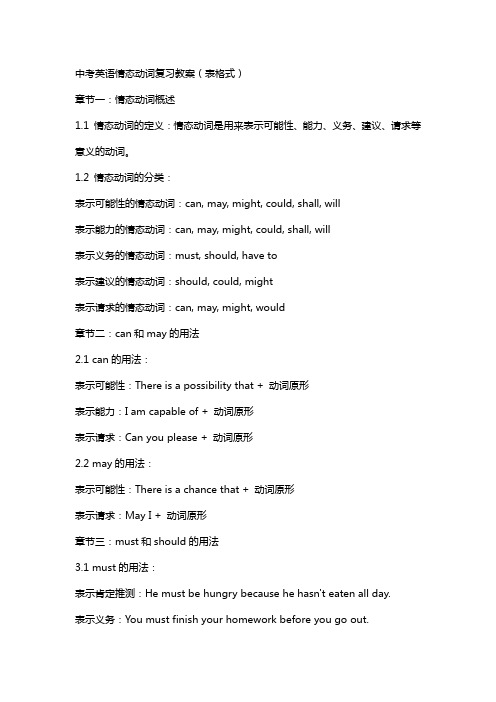
中考英语情态动词复习教案(表格式)章节一:情态动词概述1.1 情态动词的定义:情态动词是用来表示可能性、能力、义务、建议、请求等意义的动词。
1.2 情态动词的分类:表示可能性的情态动词:can, may, might, could, shall, will表示能力的情态动词:can, may, might, could, shall, will表示义务的情态动词:must, should, have to表示建议的情态动词:should, could, might表示请求的情态动词:can, may, might, would章节二:can和may的用法2.1 can的用法:表示可能性:There is a possibility that + 动词原形表示能力:I am capable of + 动词原形表示请求:Can you please + 动词原形2.2 may的用法:表示可能性:There is a chance that + 动词原形表示请求:May I + 动词原形章节三:must和should的用法3.1 must的用法:表示肯定推测:He must be hungry because he hasn't eaten all day.表示义务:You must finish your homework before you go out.3.2 should的用法:表示建议:You should study more if you want to pass the exam. 表示义务:You should help your parents with household chores. 章节四:情态动词的否定和疑问句4.1 否定句:can的否定句:I can't speak French.may的否定句:You may not leave the classroom now.must的否定句:You must not eat before the exam.should的否定句:You should not stay up late.4.2 疑问句:can的疑问句:Can you help me with this?may的疑问句:May I borrow your book?must的疑问句:Must you leave now?should的疑问句:Should we go to the park?章节五:情态动词的时态5.1 情态动词的一般现在时:can的现在时:I can swim.may的现在时:She may e to the party.must的现在时:He must finish his work.should的现在时:You should study every day.5.2 情态动词的一般过去时:can的过去时:I couldn't answer the question.may的过去时:She may have finished her homework.must的过去时:He must have left the house.should的过去时:You should have studied for the exam.章节六:情态动词的被动语态6.1 情态动词的被动语态构成:情态动词+ be + 过去分词6.2 被动语态的用法:can的被动语态:The window can be opened.may的被动语态:The letter may be written him.must的被动语态:The door must be locked.should的被动语态:The report should be submitted tomorrow.章节七:情态动词的短语搭配7.1 can的短语搭配:can't help but + 动词原形:I can't help but laugh when I see him.can't do anything about:We can't do anything about the weather.7.2 may的短语搭配:may as well + 动词原形:I may as well go to the party.may not have + 动词过去分词:She may not have finished her homework. 章节八:情态动词的考试题型8.1 选择题:选出正确的情态动词填空:He ____________ finish his work on time. (can, may, must, should)8.2 填空题:根据语境选择合适的情态动词填空:If you ____________ be quiet, you will pass the exam. (can, may, must, should)章节九:情态动词的实战练习9.1 编写一段对话:使用不同情态动词编写一段日常对话,例如:A: Can you help me with this?B: Yes, I can. Here you are.9.2 改写句子:Original: He is taller than his brother.Revised: He ____________ be taller than his brother. (can, may, must, should)章节十:情态动词的综合复习10.2 情态动词的测试:设计一份情态动词的测试,包括选择题、填空题、改写句子和对话编写等题型,以检验学生对情态动词的综合掌握情况。
(完整版)情态动词教案
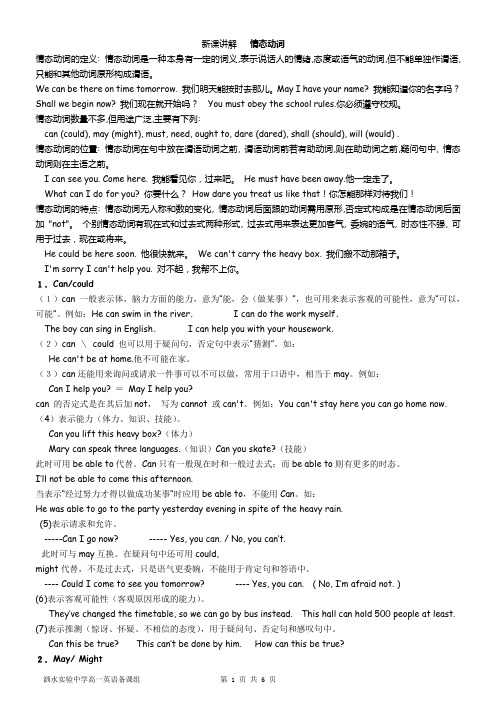
新课讲解情态动词情态动词的定义: 情态动词是一种本身有一定的词义,表示说话人的情绪,态度或语气的动词,但不能单独作谓语, 只能和其他动词原形构成谓语。
We can be there on time tomorrow. 我们明天能按时去那儿。
May I have your name? 我能知道你的名字吗?Shall we begin now? 我们现在就开始吗?You must obey the school rules.你必须遵守校规。
情态动词数量不多,但用途广泛,主要有下列:can (could), may (might), must, need, ought to, dare (dared), shall (should), will (would) .情态动词的位置: 情态动词在句中放在谓语动词之前, 谓语动词前若有助动词,则在助动词之前,疑问句中, 情态动词则在主语之前。
I can see you. Come here. 我能看见你,过来吧。
He must have been away.他一定走了。
What can I do for you? 你要什么?How dare you treat us like that!你怎能那样对待我们!情态动词的特点: 情态动词无人称和数的变化, 情态动词后面跟的动词需用原形,否定式构成是在情态动词后面加"not"。
个别情态动词有现在式和过去式两种形式, 过去式用来表达更加客气, 委婉的语气, 时态性不强, 可用于过去,现在或将来。
He could be here soon. 他很快就来。
We can't carry the heavy box. 我们搬不动那箱子。
I'm sorry I can't help you. 对不起,我帮不上你。
1.Can/could(1)can 一般表示体,脑力方面的能力,意为“能,会(做某事)”,也可用来表示客观的可能性,意为“可以,可能”。
中考英语 情态动词复习教案(表格式)

中考英语情态动词复习教案(表格式)章节一:Can/May的用法1.1 学生能够理解can/may表示能力/请求/可能性。
1.2 学生能够正确使用can/may构造疑问句和否定句。
1.3 学生能够运用can/may表达过去的能力/请求/可能性。
章节二:Must/Have to的用法2.1 学生能够理解must/have to表示必须/需要。
2.2 学生能够区分must/have to在肯定句、疑问句和否定句中的用法。
2.3 学生能够运用must/have to表达过去必须/需要。
章节三:Shall/Will的用法3.1 学生能够理解shall/will表示将来/意愿。
3.2 学生能够正确使用shall/will构造疑问句、否定句和条件句。
3.3 学生能够运用shall/will表达过去将来/意愿。
章节四:Could的用法4.1 学生能够理解could表示可能性/能力/礼貌请求。
4.2 学生能够正确使用could构造疑问句、否定句和条件句。
4.3 学生能够运用could表达过去可能性/能力/礼貌请求。
章节五:Be/Have to的用法5.1 学生能够理解be/have to表示状态/必须。
5.2 学生能够区分be/have to在肯定句、疑问句和否定句中的用法。
5.3 学生能够运用be/have to表达过去状态/必须。
教学方法:1. 通过表格对比,让学生直观地理解不同情态动词的用法。
2. 通过例句和练习,让学生掌握情态动词的疑问句、否定句和条件句的构造。
3. 结合实际场景,让学生学会运用情态动词表达过去的能力、请求、可能性、必须和意愿。
教学评估:1. 通过课堂练习和作业,检查学生对情态动词用法的掌握程度。
2. 通过小组讨论和角色扮演,评估学生运用情态动词的实际能力。
3. 定期进行测验,了解学生对情态动词知识的掌握情况。
中考英语情态动词复习教案(表格式)章节六:Mustn't/Not allowed to的用法6.1 学生能够理解mustn't/not allowed to表示禁止/不允许。
初三中考初中英语情态动词教案含答案

初三中考初中英语情态动词教案含答案一、选择题1.A lot of online resources ________ be used either by teachers at school or parents at home. A.can B.should C.need D.must2.To my joy, we_________ go to the bank. Mary has lent us some money.A.shouldn’t B.needn’t C.couldn’t D.woul dn’t3.—In China, many students have to stay up late to do their homework.—No worries. The government has realized the problem. I’m sure there ________ be good news soon.A.can B.should C.must D.need4.—May I have some wine to drink?—No, you ________. You have to drive home later.A.mustn’t B.needn’t C.can’t D.may not5.—I don’t care what people think.—Well, you _______ . Some opinions are worth weighing.A.should B.might C.could D.would6.You ________ drive after drinking alcohol(酒). It’s against the la w.A.mustn’t B.needn’t C.couldn’t D.wouldn’t 7.—Hurry up, Jack! Let’s cross the road as fast as possible.—No, you ________. Don’t you see the light is still red?A.couldn’t B.wouldn’t C.mustn’t D.needn’t 8.—There is a knock at the door.—It ________ be my mom. She always comes back home at this time.A.may B.may not C.must D.can’t9.We shouldn’t throw any objects from the building. Even a small object ________ cause serious injuries or death, when dropped from a great height.A.must B.should C.may D.need10.— Is Lang Lang going to perform at Art Center this Friday?— Yes. It ________ be him. He has been here for three days.A.might B.must C.mustn’t D.may 11.Exercise is helpful but it ________ be regular (规律的) exercise.A.must B.may C.can D.need 12.—Mum, I bought some strawberries on my way home.—Oh, you’re so sweet. But the strawberries ________ be put into the fridge for freshness. A.must B.can C.may D.need13.— Mom, must I clean my room now?— No, you ________. You can do it after dinner.A.needn’t B.must n’t C.shouldn’t D.can’t 14.—How beautiful the winter jasmines (迎春花) are!—Yes. These golden-yellow flowers ________ be widely seen in my city in March.A.must B.can C.would D.should15.It’s amazing that the pen ________turn voice into text with few mistake s.A.can B.must C.may D.need16.If you buy your mum an iRobot floor cleaner, she ________ sweep the floor every day. A.can’t B.mustn’t C.needn’t D.shouldn’t 17.The boy is very brave.I ________ he ________ the tall tree.A.dare say; dares to climbB.dare to say; dare climbingC.dare saying; dares climbD.dare to say; dares climbed18.—The high school entrance examination is coming!—Yes, our teacher tells us we _______ be too careful while taking exams.A.mustn't B.shouldn't C.needn't D.can't19.---Will you be back early this evening?---Yes, but I ________ be a little late. Our boss sometimes has extra work for us.A.may B.must C.need D.will20.We’ve discussed every detail of this plan and have got everything ready. But still something __________ go wrong. We still have to be very careful.A.must B.should C.would D.may21.When I was young, my father ___________ take me to climb the hill which was not far from our house.A.may B.must C.would D.should 22.—Shall we go camping this summer holiday?—Nothing________be better.A.should B.could C.must D.may23.Dr. Zhong Nanshan once said, "To prevent the spread of this disease, we________never be too careful."A.can B.may C.must D.should 24.Don’t cross the road until the traffic lights turn green. A car_______hit you.A.need B.may C.should D.must25.You ________ write the report again because spelling mistakes are not allowed at all. A.must B.can C.may D.could26.We've discussed every detail of this plan and have got everything ready. But still something ________ go wrong. We still have to be very careful.A.must B.should C.would D.may 27.—Could I join you in the programme?—Sorry, you ________. You are too young.A.shouldn’t B.mustn’t C.can’t D.needn’t 28.—Who is singing next door? It sounds like a young girl’s voice.—It _________ be Jane. But she seldom sings English songs.A.need B.must C.may D.can29.To avoid ________, we’d better ________ the parents’ meeting online.A.gather; hold B.gathering; hold C.gather; holding D.to gather; to hold 30.You ________ require others to do with the problem like you. Everyone has his own way. A.mustn’t B.needn’t C.may not D.shouldn’t 31.—How do you like my new dress?—Well, if I ________ say, it is not suitable for you.A.may B.must C.have to D.should 32.—Must the children leave at six tomorrow morning?—No, they _______. They can have more time to get ready for the trip.A.can’t B.needn’t C.mustn’t D.may not 33.—Why didn’t you tell it to me earlier?— Why ________ I? I want to have my own secret.A.can B.may C.should D.shall 34.—Mum, why do I have to wear a mask before entering the supermarket?—For your health and safety, you ________ be too careful.A.shouldn’t B.can’t C.mustn’t D.needn’t35.A hard-working man ________ become a great scientist, but a great scientist ________ be a hard-working man.A.can’t; can B.may not; must C.can’t; must D.may not; can 36.According to the rule, used batteries ________ be dropped in the red bin for harmful wastes. A.may B.would C.should D.might37.— What do you think of the show yesterday?— Some of them were really good but others ________ be better.A.will B.must C.need D.can38.—Must I finish all my homework today, Mum?—No, you ________, my dear. You can finish some tomorrow if you like.A.needn’t B.shouldn’t C.can’t D.mustn’t39.—Is it really necessary for me to go shopping with a mask on?—I’m afraid you ________ in public. It is not only to protect yourself but also to protect others. A.must B.should C.can D.need40.Never throw objects from the building. Even a small object ________ cause serious injuries, or death, when dropped from a great height.A.must B.should C.may D.need41.—In China, many parents complain that their children have to stay up late to do the homework.—Don’t worry. The government has realized the problem. I’m sure the re ________ be good news soon.A.can B.should C.need D.must42.I think all the students love the weekends because, to them, they ________ get up early on Saturdays or Sundays.A.mustn’t B.don’t need C.needn’t D.can’t43.—Is it usually warm in Yancheng in May?—Yes. But it _______ be rather cold sometimes.A.must B.should C.would D.can44.— Is the boy over there Tom? He often wears a jacket like that.— It _______ be him. He is absent from school today.A.needn’t B.shouldn’t C.mustn’t D.can’t45.You ________ pay too much attention to protecting yourself if you plan to go abroad. A.mustn’t B.can’t C.shouldn’t D.needn’t 46.—Will dad arrive home at 6 o’clock to have dinner with us this evening?— I think he will, but he ________ not. Sometimes he works extra hours.A.can B.must C.need D.may47.Look at the floor, Tom! ________ you watch TV while having a meal?A.Should B.Could C.Must D.May48.You’ve got an A in the maths test again. You ________ be good at it.A.can B.may C.must D.should 49.—The article says tha t a person’s animal sign decides his personality.—You ________ read it for fun, but don’t believe in that.A.can B.must C.shouldn’t D.needn’t 50.You _________ smoke here! Look at the sign. It says "No smoking".A.needn't B.mustn't C.can D.may【参考答案】***试卷处理标记,请不要删除一、选择题1.A解析:A【详解】句意:很多在线资源既可以供学校的老师使用,也可以供家长在家使用。
中考英语专题复习 情态动词【教案】
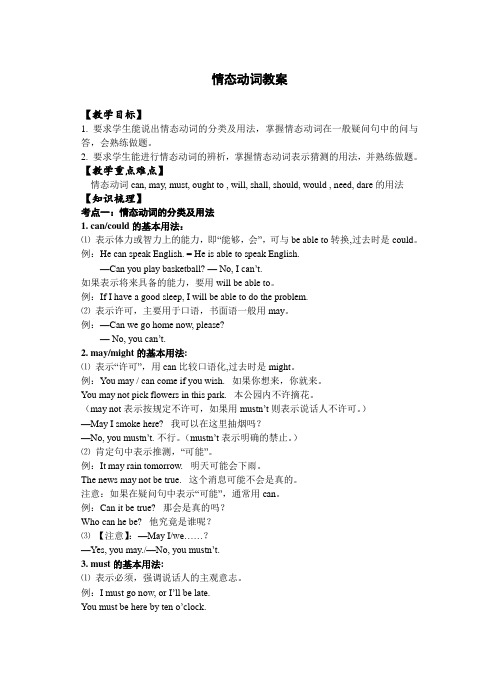
情态动词教案【教学目标】1. 要求学生能说出情态动词的分类及用法,掌握情态动词在一般疑问句中的问与答,会熟练做题。
2. 要求学生能进行情态动词的辨析,掌握情态动词表示猜测的用法,并熟练做题。
【教学重点难点】情态动词can, may, must, ought to , will, shall, should, would , need, dare的用法【知识梳理】考点一:情态动词的分类及用法1. can/could的基本用法:⑴表示体力或智力上的能力,即“能够,会”,可与be able to转换,过去时是could。
例:He can speak English. = He is able to speak English.—Can you play basketball? —No, I can’t.如果表示将来具备的能力,要用will be able to。
例:If I have a good sleep, I will be able to do the problem.⑵表示许可,主要用于口语,书面语一般用may。
例:—Can we go home now, please?—No, you can’t.2. may/might的基本用法:⑴表示“许可”,用can比较口语化,过去时是might。
例:You may / can come if you wish. 如果你想来,你就来。
You may not pick flowers in this park. 本公园内不许摘花。
(may not表示按规定不许可,如果用mustn’t则表示说话人不许可。
)—May I smoke here? 我可以在这里抽烟吗?—No, you mustn’t.不行。
(mustn’t表示明确的禁止。
)⑵肯定句中表示推测,“可能”。
例:It may rain tomorrow. 明天可能会下雨。
The news may not be true. 这个消息可能不会是真的。
- 1、下载文档前请自行甄别文档内容的完整性,平台不提供额外的编辑、内容补充、找答案等附加服务。
- 2、"仅部分预览"的文档,不可在线预览部分如存在完整性等问题,可反馈申请退款(可完整预览的文档不适用该条件!)。
- 3、如文档侵犯您的权益,请联系客服反馈,我们会尽快为您处理(人工客服工作时间:9:00-18:30)。
学习过程一、复习预习复习上节内容,画助动词、实义动词的时态特点图,词性和句子成分对应图二、知识讲解考点1---情态动词特点与分类1、情态动词:情态动词具有有一定的词义,没有人称和数的变化,不能单独作谓语,必须和谓语动词连用才能构成谓语,给谓语动词增添情态色彩,表示说话人的态度、看法、语气、愿望或推测等。
2、情态动词分类:①只做情态动词:must,can(could),may(might),ought to②可做情态动词又可做实义动词:need,dare③可做情态动词又可做助动词:shall(should),will(would)④具有情态动词特征:have(had) to,used to考点2---情态动词用法用法:情态动词+行为动词原形情态动词数量不多,但用途广泛,主要有下列:can /could, may/might, must, need, ought to, dare/dared, shall/should, will/would,have(to) ,had better.must和have to的用法1.表示必须、必要、一定。
(must表示主观多一些而have to则表示客观多一些)如: You must come in time.回答must的问句时,肯定回答为must,否定回答用needn't或don't have to。
— Must we hand in our exercise books today?— Yes, you must. (No,you needn’t.或No, you don’t have to.)2.Must用于肯定的判断、推测时,表示的可能性最强。
The light is on ,so he must be at home now.其反义疑问句要用实际问句的助动词来构成She must have seen the film before, hasn’t she?You must met uncle wang in the shop yesterday, _________?3.否定形式mustn’t表示“一定不要、千万别、禁止、不许”You mustn’t play with fire.will和would的用法1. 表示请求、建议等,would比will委婉客气。
如:Would you pass me the book?2. 表示意志、愿望和决心。
如:I will never do that again.They asked if we would do that again.can (could) 用法:can (could) 表示说话人能,可以,准许,以及客观条件许可,could 为 can 的过去式(1).can表示能力,译为“能、会”即某种能力是与生俱来的,Could表示过去的能力She can swim fast,but i can’t.He could write poems when he was 10*此时可以用be able to 来表示和替代(2).can表示许可或者请求,常用于口语中。
Could在疑问句中表示委婉的语气,此时没有过去时的意思you can use my dictionary。
Can you pass me the books?Could you do me a favour? Could i use your pen?(3).can表示推测,意为“可能”,常用于疑问句和否定句,can’t 为“不可能”Can the news be true?It can’t be our teacher, he is on the visit to the Great Wallmay (might) 用法(1).may表示请求、许可,比can/could正式You may take the book home. 你可以把书带回家去.May I come in? 我可以进来吗?(2).may表示推测,谈论可能性时,意为“或许、可能”,一般用于肯定句中Might为may的过去时,表推测时可能性低于mayIt may rain rain tomorrow.She may be at homeHe is away from school,he might be sick(3).may表示希望、祈求、祝愿时,通常结构“may+主语+动词”May you have a good timeshall 用法表示征求对方意见,多用于第一第三人称:shall we go out for a walk?should 用法(1).should意为“应该”,表示劝告、建议、责任、义务We should protect the environment(2).should 还可以表示推测,可能性较大,仅次于mustHer face turn red, she should be shyneed 用法(1).表示需要、必须,主要用于否定句和疑问句中其否定形式为needn’t,意为“没有必要,不必”用need 提问时,肯定回答为must,否定回答为needn’t或don’t have to Need i stay here any longer?--yes, you must.-----No ,you needn’t/don’t have to(2).need 还可以作实义动词,此时有人称和数的变化。
以人做主语,常接不定式 i need to do it right now以物作主语,常接 need doing 都是被动意义Need to be doneThe door needs painting = the door need to be painteddare用法意为“敢于,敢”,用法近似need作情态动词,多用于疑问、否定或条件句中,无三单形式,只有一般现在时和一般过去时作实义动词,有人称和数的变化,后加to不定式,口语中常省略tohad better 用法意为“最好”,没有人称的变化,后接不带头的不定式。
否定had better not考点3---感情色彩强弱比较表推测可能性由大到小must should can could may mightMust表示肯定的推测,一般用于肯定句中Should表示的可能性较大,仅次于mustIt is already 10 o’clock they should be thereCan 表示推测时用于否定和疑问句中that man can’t be her husbands,he is singleCould 表推测时语气比can弱,表示说话留有余地Could it be an animal? --it could not be,because it is not moving May 表推测谈论可能性时,意为“或许、可能”,一般用于肯定句中Might表推测时,不一定为may的过去时,只是表示可能性低于may考点4---情态动词的否定1. mustn’t否定形式表示“一定不要、千万别、禁止、不许”You mustn’t play with fire.mustn’t 也可用于回答May的许可疑问句中May i stand here?--no, you mustn’t/ can’t2. can’t否定形式表示能力时,为“不可能”表示许可或请求时,表禁止、不许,用来回答“may i ../can i ..”问句May i come in?--no, you mustn’t/ can’t表示推测时,表达不可能还可以用于一些习语中.can’t help doing情不自禁做 can’t wait to do迫不及待做。
3.May not 否定形式为“可能不”, she may not be at home4.Needn’t 否定形式为不必。
You needn’t meet him unless you’d like toNeedn’t have done 表不需要完成但已完成的动作,暗含浪费时间精力You needn’t have bought it5.Shouldn’t 表不应该,you shouldn’t feel so unhappy over such little things Shouldn’t have done 表不应该完成但已完成的动作,表对过去动作的责备批评You shouldn’t have borrowed his money考点4---情态动词的疑问句回答1. 对may引出的问句回答方式:Yes,you may/Yes,certainly/Sure. No, you mustn’t/ can’t 2.对must引出的问句回答方式:Yes,...must. No, ...needn’t / don’t have to3.对could引出的问句表示委婉的语气,此时could没有过去时的意思回答方式:Yes,you can No, you can’t4.对shall引出的问句,只用于第一人称,表示征求对方意见或客气的请求回答方式:Yes,please/all right No,thank you5.对would you...引出的问句回答方式:Yes,i will/Sure/all right/OK/with pleasureNo,i won’t / i’m sorry,i can’t/No,thank you 五、课程小结。
